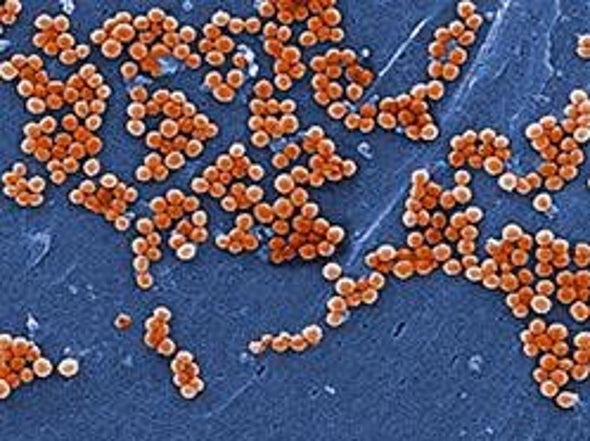(单词翻译:单击)
听力文本
This is Scientific American's 60-second Science, I'm Christopher Intagliata.
If you’re a germaphobe navigating the city, there are certain mandatory rules of engagement: Use a paper towel to shield your hand as you touch the bathroom door handle. Lift toilet seat covers with your shoe. Touch buttons at ATMs, and crosswalks, and elevators with a knuckle or the back of your hand—never a fingertip. I know this, because I am that person.
And a new study in the journal Scientific Reports somewhat justifies my behavior. Because when researchers in London sampled all those kinds of surfaces—in public shopping centers, train stations and common areas in hospitals—they found a whole lot of antibiotic-resistant bacteria lurking there.

The scientists swabbed sites all over London and ended up with 600 samples of Staphylococcus bacteria. Of those, nearly half were resistant to two or more commonly used antibiotics, like penicillin and erythromycin. And the hospital samples had significantly more drug-resistant microbes—which makes sense, because hospitals are places where they use a lot of antibiotics.
But there’s a silver lining here, it might be how few staph bacteria were multidrug-resistant in public places: a mere 47 percent. Because a few years back, one of the same scientists swabbed London hotel rooms—and found that 86 percent of the staph bacteria there were multidrug resistant. Which may not help you sleep easy.
Thanks for listening for Scientific American — 60-Second Science. I'm Christopher Intagliata.
参考译文
这里是科学美国人——60秒科学系列,我是克里斯托弗·因塔格里塔。
如果你是个在城市中穿行的细菌恐惧症患者,那你会有某些强制的约定规则:触摸卫生间门把手时用纸巾垫着。用脚掀开马桶盖。用指关节或手背按自动取款机、人行横道和电梯的按钮——绝对不用指尖。我知道这一点是因为我就是这样的人。
《科学报告》期刊上发表的一项新研究多少证明了我的行为是合理的。因为当伦敦研究人员在公共购物中心、火车站和医院公共区域里上述所有表面取样时,他们发现,那些地方都潜伏着大量的耐抗生素细菌。
科学家用棉签擦拭了全伦敦的上述地点,最终得到了600个葡萄球菌样本。当然,其中近一半对两种或两种以上的常用抗生毒有抗药性,比如青霉素和红霉素。医院样本中的耐药细菌明显更多,这合情合理,因为医院是大量使用抗生素的地方。
但还有一线希望,可能是公共场所的葡萄球菌的多重耐药性很低,只有47%。因为几年前,参与此项研究的一名科学家曾用棉签擦拭伦敦酒店房间,发现那里86%的葡萄球菌都具有多重耐药性。这可能会让你睡不安稳。
谢谢大家收听科学美国人——60秒科学。我是克里斯托弗·因塔利亚塔。
译文为可可英语翻译,未经授权请勿转载!
重点讲解
重点讲解:
1. a whole lot of 许多;很多;
Pour a whole lot of cold water over the rice, and bung it in the oven.
往米中倒入大量凉水,然后放在炉子上。
2. end up 最终;结果;到头来;
If they take this game lightly they could end up with egg on their faces.
如果他们对这场比赛掉以轻心,结果很可能会出丑。
3. be resistant to 有抵抗力的;不受…损害的;
Cotton is more resistant to being squashed and polyester is more resilient.
棉布更抗压,而涤纶更有弹性。
4. make sense 有道理,合乎情理;
It all makes sense now.
现在就都讲得通了。


